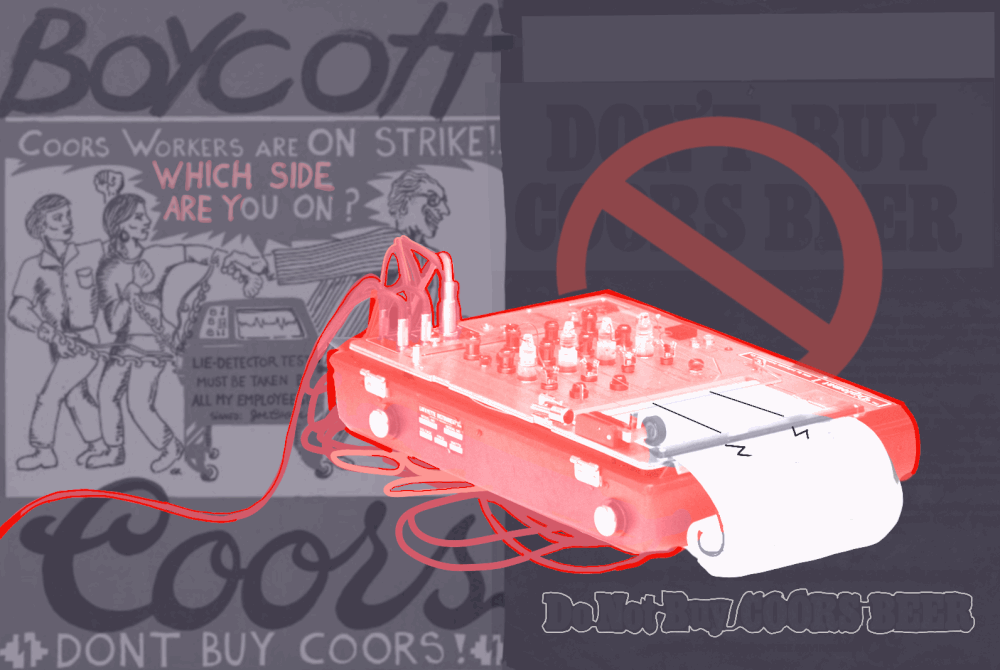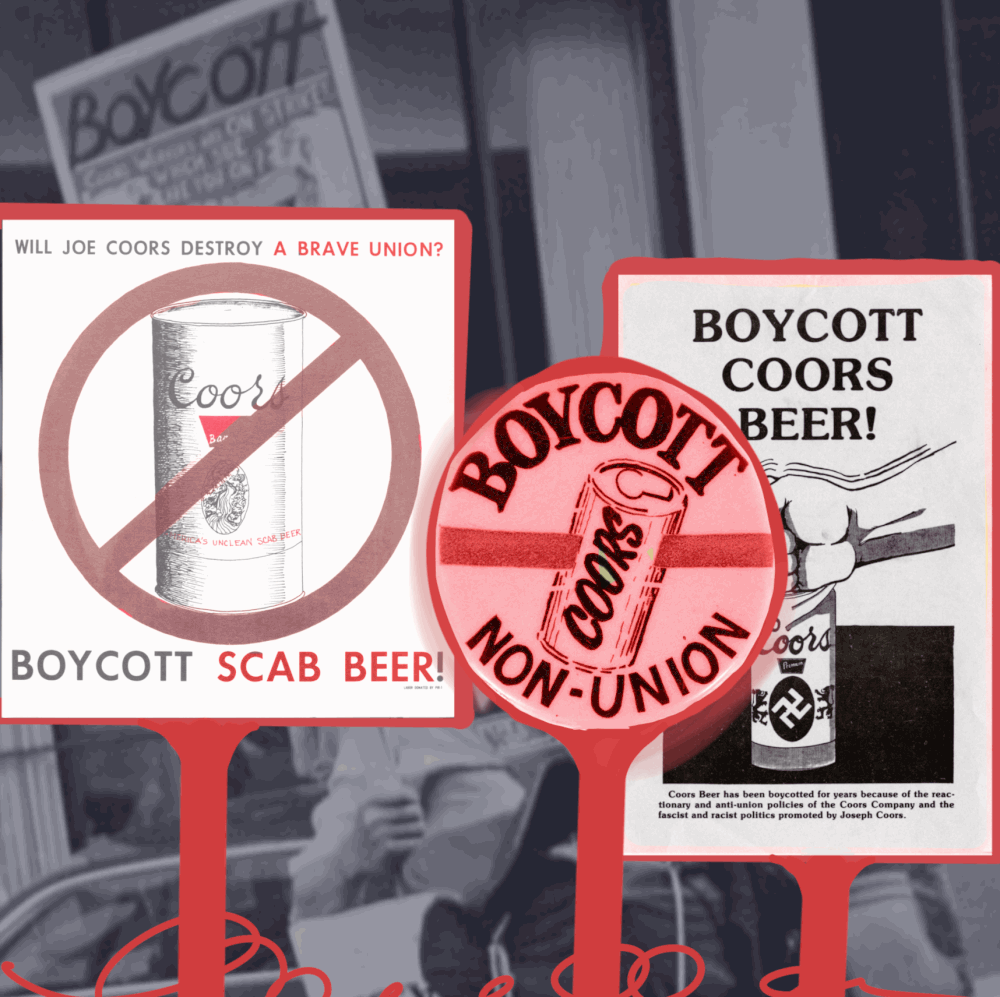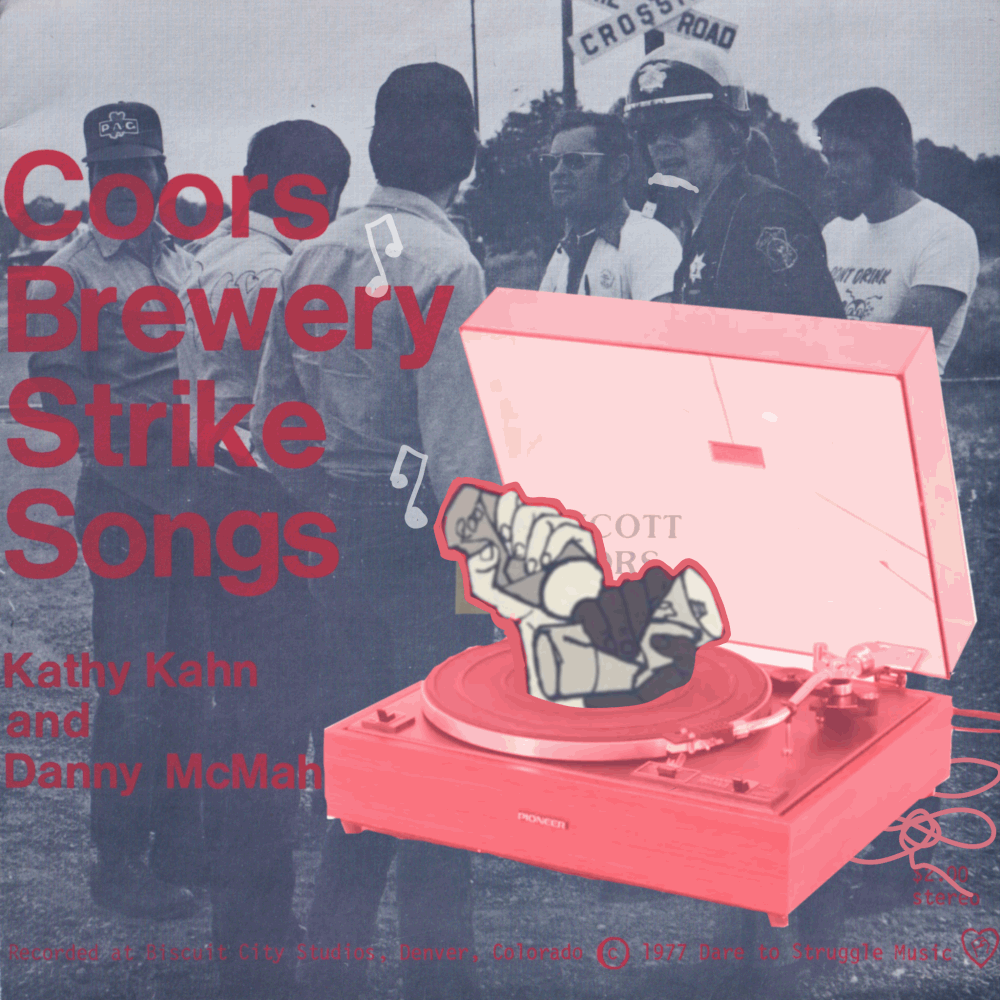
In the early 1970s, the International Brotherhood of Teamsters labor union wasn’t known for playing nice. Teamsters at the time had a reputation for shady mob connections—think Jimmy Hoffa—and violent scrapes with other unions, such as the United Farm Workers (UFW). A large portion of its membership was known not just for being socially conservative, but downright racist and homophobic. These weren’t exactly the first people progressive leftist organizers thought to ally with.

So when Howard Wallace, one such organizer and an openly gay man, saw striking Teamsters from San Francisco’s Local 888 chapter picketing outside a supermarket in the Castro district, it wasn’t the Teamsters themselves who caught his eye. Rather, he was intrigued by what they were protesting: Coors beer.
AUTHOR’S NOTE
This article contains some outdated terminology, like “gay” instead of “queer” or “LGBTQIA+,” as well as “Chicano” instead of “Latino/a/x” or “Hispanic.” We’ve retained these terms in cases of quotations from historical figures, proper nouns, and other acts of self-description in order to reflect the way people were represented and the ways they saw themselves in the past. When providing our own thoughts and voice, however, we will use inclusive language according to contemporary best practices. Because we cannot know whether historic figures would have identified as Hispanic or Latinx, we have used both terms. If you’d like to learn more about the considerations around these terms, a recent discussion among journalists and sociologist G. Cristina Mora can be found here.
Wallace was a Denver transplant, so he knew Coors and its reputation all too well. A seasoned activist committed to what was then called “gay liberation” (which would become the modern LBGTQIA+ movement), Wallace readily believed accusations that Coors exploited its workforce and discriminated against underrepresented communities. An anti-Coors boycott this far from home naturally intrigued him, and Wallace soon found himself in conversation with its leader, Allan Baird.
Baird was working tirelessly to build support for the Teamsters’ boycott among the local community, and asked Wallace for his help. Wallace quickly posed the key question: If the Teamsters wanted others to help them, what were the Teamsters doing to help others?
Baird had been hearing that all over town, and he had an answer ready: The Teamsters did need to do more, and they were starting to.
So Wallace and Baird gave each other a chance. Baird gave Wallace some leaflets to pass out in his left-leaning circles, and in return promised to gather some Teamsters to join the picket lines for a UFW boycott of California grapes that Wallace was supporting. This was no small ask, given the Teamsters’ history, but Baird held up his end of the bargain, and a partnership was born.
The alliance between Bay Area labor unions and queer activists still thrives to this day. This early alignment was also one of the pivotal moments in the history of the Coors boycotts, a decades-long struggle that pitted the brewery against a coalition of union members and activists from queer, Hispanic/Latinx, Black, Indigenous, and progressive communities throughout the West, one that became no less than an ideological battle for the soul of America.
Officially speaking, the Coors boycotts lasted 30 years, from 1957 to 1987, making them one of the longest-running grassroots consumer efforts of the 20th century. Seeded by labor strikes in both Coors’ homebase of Golden, Colorado and San Francisco, the boycotts brought together a motley crew of progressive supporters from all walks of life. They pushed back against not only Coors, the company, but also Coors, the family, whose management policies were just one facet of their zealous commitment to American conservatism. As the Boston Globe observed in 1981, “Almost any liberal group can find something about Coors to gripe about.”
Our story will focus on queer boycotters, particularly in the San Francisco area, whose efforts helped give the boycotts untold reach and meaning. But other contributors, particularly Hispanic/Latinx activists throughout the American West, made their own massive contributions to the movement. The whole story is chronicled in Brewing a Boycott: How a Grassroots Coalition Fought Coors and Remade American Consumer Activism, a new book by Allyson P. Brantley, a professor of history at the University of La Verne. The Coors boycotts story is one of Pyrrhic victories, but it also contains incredible solidarity, endurance, and the potential of coalition-based consumer activism. And it explains why, to this day, you’ll be hard-pressed to find Coors on tap at any queer bar in the Castro.
COLD FILTERING
When the first call to boycott Coors rang out in April 1957, it had nothing to do with queer rights or San Francisco. Nearly a thousand miles away in Golden, Colorado, the managers of the Coors brewery were squaring off against their employees’ union, United Brewery Workers Local 366, over wages. The strike lasted an impressive 117 days despite fierce new union-busting tactics by Coors, like making replacement (scab) labor permanent and reassigning union jobs to subcontractors. But one of the union’s most effective tools was its boycott. Local 366 dispatched picketers throughout Colorado, urging union members to stop buying Coors beer. The tactic worked to an extent, but the boycott focused on gathering union support over that of the general public, limiting its reach. Coors held firm and forced the union to return to work without any real concessions.
This inauspicious start left Coors emboldened. Legend has it that Bill Coors, then chairman of the company, vowed he would never again let the union tell him how to run his family’s brewery. But union workers weren’t the only ones with a bone to pick.
The boycott mantle was soon taken up by local Hispanic/Latinx civil rights groups. Many Mexican-American residents in Golden reported experiencing discrimination at Coors, either in the workplace or, even more frequently, when applying for jobs. As part of the wider “Chicano” movement through which many Americans of Mexican descent sought to empower themselves within U.S. society, these activists linked Local 366’s boycott approach with a larger call for political and social justice, demanding reforms at the brewery that mirrored what was needed in the broader culture. These activists also spread the boycott through the American West and Southwest—in one case, by driving a van covered in “Boycott Coors!” signs from New Mexico to California.

One of the most resonant criticisms of Coors’ treatment of its employees was its use of polygraph or lie-detector testing in both hiring and workplace disputes. Polygraphs in government and corporate settings were all too common during the Cold War era, ostensibly deployed to weed out Communists as well as so-called “sexual deviants.” Tests like these were particularly invasive, offensive, and even dangerous for LGBTQIA+ individuals, but pretty much every employee considered the polygraph to be a “witch-hunting tool.”
“Mexican-American and Chicano activists … said at one point, like if you don’t think like a gringo, [meaning] if you don’t think like a white person, you can’t pass the test,” says Brantley, who interviewed several of these early boycotters for her book. Coors’ barrage of questions, she recounts, included deeply personal probes into sexual behaviors and preferences. And even seemingly innocuous questions—about how often an applicant fought with their parents, or whether they’d ever been involved in a protest—seemed to screen workers for certain political values, as well as their pliability to corporate control. As Hispanic/Latinx activists expanded the boycott both conceptually and geographically, the polygraph would remain a significant rallying point for boycotters across the progressive spectrum.
Animus against Coors also spread another important way: through the brewery’s distributorships. The beer’s popularity in the 11 Western states where it was distributed allowed the company to be selective about who handled its beer. Coors’ unpasteurized product did require cold storage and more careful handling, but it wasn’t just that. The company also leveraged its power to select distributors for commitment as much as equipment—both to company values and keeping labor costs down, i.e. keeping the unions in their place. By the mid-1960s, Coors had a fleet of sympathetic distributors putting the same pressures on union delivery drivers as the brewery put on its workers.
That’s where the Teamsters came in. Tensions got particularly high in California, where wage and benefits disputes between beer distributors and local delivery drivers led to regular strikes and boycotts. By and large, these efforts followed the same basic playbook Local 366 had used in Colorado: the one that prioritized union solidarity over public campaigns, and was already known to be ineffective against Coors. Year after year, California’s Teamsters strikers barely held the line as Coors (and one or two like-minded beer companies) explored new and better ways to erode union power.
That is, until Baird met with people like Howard Wallace in 1973—and Local 888 tried a new strategy.
GET COORS OUT OF YOUR BAR
“[The boycott] was not going very well in the summer of ’73,” says Brantley. Local 888’s latest strike against beer distributors had forced a few of the companies to the negotiating table, but Coors held out. So the Local asked Baird and another Teamster named Andy Cirkelis, both seasoned leaders in other chapters, to take over the campaign.
They rekindled the boycott by literally turning up the volume: Baird got a bullhorn and used it to annoy retailers into compliance. It worked for a while, but Baird and Cirkelis needed a broader strategy. So they decided, in an echo of the outreach to Howard Wallace, to try and revamp Local 888’s boycott by reaching out to progressive communities within the Bay Area. As Brantley says, “They were at the right place at the right time.”
After all, San Francisco already had a long history of coalitional politics. Throughout the 1960s, the area’s Black, Hispanic/Latinx, Asian-American, and Indigenous communities had formed racial justice organizations, fighting both separately and together against poverty, police brutality, and systemic discrimination in employment and housing. Following the 1969 Stonewall riots in New York City, San Francisco had become a stronghold of bold, outspoken activism for LGBTQIA+ rights. Legendary leaders such as Harvey Milk—the activist who became California’s first openly gay elected official, only to be tragically assassinated along with the city’s mayor in 1978—were forged in the crucible of the Castro. Baird and Milk happened to be neighbors, but they soon became allies as well. (Milk even borrowed Baird’s bullhorn, putting it to such good use that it’s currently on display in the Smithsonian, on loan from the GLBT Historical Society.)
Baird reached out to other organizations too, like the Black Panthers and Chicano community groups. To earn their trust and support, the Teamsters’ more progressive members, including Baird and Cirkelis, worked to change their organization from within. They spearheaded an equal-employment plan through which union leaders could work to diversify their places of employment. Local 888 further worked to get more Black, Hispanic/Latinx, Asian-American, Indigenous, and female drivers hired into positions represented by the union.
These efforts also led to union positions for “out-front gay” people at Bay Area beer distributors. Howard Wallace himself was the first hire under this campaign, but he shrugged off the significance, saying, “There’s always been hundreds of thousands of gays in the Teamsters union.”
Even so, moves like these helped Teamsters and many queer residents find common cause in the Coors boycott. “It may be hard for many gays to go to the help of the union,” Milk said to skeptics, “but it is a union that has admitted it has been wrong in the past.” This approach worked: Coors beer began to disappear from store shelves across the Bay Area, and especially from gay bars.
Of course, such alliances weren’t just about quid pro quo. As we saw, Coors’ workplace practices, such as the polygraph, presented real dangers to any LGBTQIA+ employees and generated palpable hostility from queer organizations, including the outspoken Bay Area Gay Liberation (BAGL) group. As Brantley describes, “After BAGL … meetings, they’d hit the bars and they’d say … ‘Hey, get rid of that! Get Coors out of your bar.’” Activists were known to take Coors bottles and kegs from bars and pour them out on the curb.
But increasingly, Wallace, Milk, and many others opposed Coors not just because of the company’s workplace tactics but because of the family behind them. The brewery’s history of discrimination, polygraphs, and union-busting wasn’t just business as usual: Those practices were manifestations of the Coors family’s politics—and, by extension, the rise of ultra-right conservatism across America.
THE BALLAD OF JOE COORS
Following the humiliation Prohibition wrought for their company, the Coors family had become fiercely opposed to any form of interference in their business, whether from unions, government, or anyone else. This attitude had likewise inspired one of the Coors sons, Joseph, to become infatuated with a growing conservative faction within the Republican Party. This faction blended free-market, anti-Communist, and “family values” (including anti-gay) rhetoric together into a vociferous new ideology that would become the modern-day religious right.
And Joe Coors didn’t just support this new political vision: He bankrolled it. Joe used the Coors fortune to fund conservative causes, both in Colorado and Washington, D.C.; by the end of the 1960s, he was good friends with Ronald Reagan. Soon after, he helped establish a think tank called the Heritage Foundation, as well as the short-lived Television News Incorporated (TVN), a propagandistic news service designed to counter the supposedly liberal bias of network news coverage. TVN is widely acknowledged today as the prototype for Fox News.

For many, Coors beer was the embodiment of Joe Coors, who in turn represented a rising and, to them, hostile political ideology. The blooming symbolism of the choice to boycott Coors brought many to Local 888’s aid. Coors’ sales in California dropped 4.6% from September 1973 to December 1974, and sales in the Bay Area specifically dropped 30% between early 1974 and summer 1975.
Baird and Cirkelis leaned hard on their coalitional strategy, catering their message to individual segments of their audience. If you were Hispanic/Latinx, you should boycott because of Coors’ history of discrimination; if you were LGBTQIA+, because of the polygraph; and so on. But there were downsides: This approach created a fractured effort without a clear, unifying message—and Local 888’s original labor dispute fell into the shadow of the boycott’s wider polemics. What’s more, not every Teamster was as progressive as Baird and Cirkelis. Union infighting at the local and national leadership levels led to Baird’s removal as a boycott leader in 1975, and within a year, Local 888 was also dissolved, its membership absorbed into five surrounding chapters.
REBOUND
But the campaign against Coors had taken on a life of its own, utilizing both intra-community networks and those forged by earlier Hispanic/Latinx boycotters. Bay Area organizers connected with counterparts in Los Angeles to begin pushing queer bars in Santa Monica and West Hollywood to end their contracts with Coors. And meanwhile, a revitalized Local 366 had renewed its fight at the Coors brewery in Golden, Colorado.
Following failed contract negotiations in 1977, Local 366 went back on strike for the first time since the 1950s, and it wanted to make sure this round went differently. One key organizer, David Sickler, studied numerous past boycott efforts, including Local 888’s in San Francisco. He formulated a plan based in large part on these efforts, and launched a boycott alongside Local 366’s strike, sending striker envoys all across the West.
Queer activist groups around the Los Angeles area endorsed the revitalized boycotts—once they, like Local 888 before them, publicly supported queer rights. Famed queer rights activist Morris Kight said of the boycott, “Every time a gay or lesbian purchases Coors, we put into Joe Coors’ pocket the very money he contributes to our worst political enemies … This is perhaps the strongest reason that exists for you to boycott Coors!”
They say a boycott tends to be a lot like a freight train—it takes a long time to get going, but once started, is very hard to stop.
L.A. activists led marches, blood drives, and rallies in support of the boycott and strike throughout 1977 and 1978. Their efforts dropped Coors’ sales in southern California by more than 20%—even costing the brewery its coveted number-one spot in that market.
And they weren’t alone. Their Bay Area neighbors kept up their end of the boycott—not only by keeping Coors out of 90% of the city’s queer bars, costing the company a staggering 5,000 cases a week in sales, but also by convincing the San Francisco 49ers football team to stop selling Coors at Candlestick Park. Boycott activity also spread to San Diego and multiple cities in Texas, from Houston to El Paso. It spread to Albuquerque; New Orleans; Missoula, Montana; Ogden, Utah; and, of course, throughout Colorado. This phase of the boycott, assisted in many cases by queer organizing, seemed to inspire the entire West.
In fact, the coalition was so successful that Local 366’s fight nearly got lost in the ether, just like Local 888 before it. While the boycott traversed the West, Coors methodically eroded support for Local 366 within the brewery walls, and managed to successfully decertify the union in late 1978. Less than a week later, the Local was essentially defunct.
Local 366 may have been busted, but Sickler and the chapter’s other leaders vowed to continue the fight. They joined with a new generation of leaders, particularly from Hispanic/Latinx, queer, and labor communities, who continued to support the boycott on a national scale—using the same broad, ideological approach employed by Baird and Local 888.
THE EMPIRE STRIKES BACK
“They say,” wrote Alan Cunningham in the Rocky Mountain News in 1977, “a boycott tends to be a lot like a freight train—it takes a long time to get going, but once started, is very hard to stop.”
He was right, but Coors and the new conservatism it represented were hard to stop, too. In 1980 Ronald Reagan became president, with Joe Coors still in his inner circle. And when their victory against Local 366 failed to diminish the boycott, Coors adopted a whole new counter-strategy.
If individually catered arguments brought diverse groups of people into the boycott, remedying their diverse grievances could take them out again.
Coors began appealing directly to the communities most opposed to their product, and catered their argument to each. To queer communities, for example, they trotted out openly queer employees at the brewery, denying the Coors family’s involvement with conservative, anti-gay initiatives.
To groups fighting for racial equality, they also offered money … and lots of it. In 1984, Coors signed two high-profile agreements with respective coalitions of Black and Hispanic/Latinx civil rights organizations, whereby the brewery would commit to hiring more people of color, invest in minority-owned businesses and banks, as well as fund scholarships and other community support programs. In exchange, leaders in these organizations would help “eliminate misconceptions” about Coors in their communities. All told, these deals represented a roughly $675 million investment.
The way we’ve had the shit kicked out of us, I can’t tell you how good it felt to kick someone else’s ass for a change.
In an overture laughably small by comparison, Coors attempted to appeal to San Francisco’s queer community by offering $10,000 to the Tavern Guild, an association of queer bar owners in the Castro, to fund a health plan for its members. In return, they had to restock Coors in their bars and encourage patrons to give it another chance. The Guild immediately refused, calling the offer a “crude bribe.”
Many boycotters rejected these moves and managed to build momentum for the boycott in the near term. When Coors, long an exclusively Western beer, began expanding eastward, the boycott followed. The beer debuted in Ohio in 1984 only to find that every queer bar in Columbus had pledged to boycott it. The city council of Detroit, Michigan passed a pro-boycott resolution in 1986 thanks to labor organizers, while university students in nearby Flint hosted Coors “throw-out parties.” The president of the Detroit-based United Auto Workers union said of the experience, “The way we’ve had the shit kicked out of us, I can’t tell you how good it felt to kick someone else’s ass for a change.”
In Chicago, 35 out of 55 queer bars refused to serve Coors beer. Local campaigns popped up in Boston; Hartford, Connecticut; and New York, typically organized by some coalition of area labor, queer, and Hispanic/Latinx organizations. As the Lesbian and Gay Labor Network in New York stated in 1987, “The Coors boycott has shown what we can do when we unite and work together.”
But that unity didn’t last. Also in 1987, the American Federation of Labor & Congress of Industrial Organizations (AFL-CIO)—which had assisted Local 366 in its boycott and taken over organizing when the chapter folded—signed a deal ending the official boycott against Coors, in exchange for token pro-union compromises by the brewery. Meanwhile, Coors kept meticulously eroding boycott support by continuing to fund community organizations. It also took other steps to ease the LGBTQIA+ community’s specific concerns.
Throughout the ’80s and ’90s, Coors sponsored AIDS walks and benefits; in 1992, the company publicly opposed the proposed Colorado state Amendment 2, which prohibited the recognition of gays and lesbians as a protected class. In 1995, Coors agreed to provide benefits to employees’ same-sex partners and suspended the infamous polygraph test. For Wallace and others on the queer left, these moves looked like a smokescreen to hide the Coors family’s continued support of conservative causes.
But the queer community, like any other, was no monolith. Others, particularly from younger generations who had not followed the boycott so closely, were more likely to believe that Coors’ efforts were genuine. Solidarity fractured, and while queer boycotters remained—and still remain to this day—their strength is a shadow of what it used to be.
REGROUP
That’s not to say they are silent, nor is their influence gone. In the late 1990s, stalwart boycotters called out Pride festival organizers along with the Gay and Lesbian Alliance Against Defamation for accepting Coors’ support. In 2004, they also spoke out when Pete Coors, then a candidate for the Colorado State Senate, endorsed a constitutional ban on same-sex marriage (prompting Coors, the company, to publicly reaffirm its commitment to queer rights). In 2016, San Francisco activist Shannon Coulter spearheaded a national boycott campaign, “Grab Your Wallet,” against companies that supported Donald Trump’s presidential campaign. Coors was included.
I try to live what Allan was about, and push myself to do community-based organizing. … He is the person we should be modeling ourselves after; the whole Teamsters union needs more Allan Bairds in it.
But the legacy of the boycott also resonates in positive ways, through the community relationships it helped forge. For example, on June 25, 2021, a joint procession of Teamsters and LGBTQIA+ activists marched through the Castro to Allan Baird’s home, holding rainbow flags beside union banners, to honor the now-octogenarian.
Tizoc Arenas, member of Teamsters Local 223 in Oregon, helped organize the event, and was blown away by how many Teamsters wanted to honor Baird’s legacy. He expected only a few people, he says, but over 200 turned out, including labor and queer community members, local elected officials, and the owners of businesses from the Castro’s legendary queer bars to Milk’s former camera shop. The impact of Baird’s work on these varied groups—who chanted “long live Allan Baird” and shared emotional anecdotes—was unmistakable.
“This was literally meeting one of my heroes,” says Arenas. “I try to live what Allan was about, and push myself to do community-based organizing. … He is the person we should be modeling ourselves after; the whole Teamsters union needs more Allan Bairds in it.”
Ruben Bustillos, an openly gay member of Teamsters Local 70 in Oakland, California, also credits Baird’s alliance with Howard Wallace and Harvey Milk for the union’s progressive evolution. “That image of the Teamsters from the past doesn’t apply anymore,” he tells us, adding that, “at my local, you’ll never see Coors. A lot of locals are like that, because they remember. A tiger can’t change its stripes.”
Indeed, that’s the issue at the heart of the queer community’s divided viewpoint on companies like Coors—one that is strongly evidenced in today’s Pride movement. Some see any acknowledgement on the part of businesses, breweries, and local and national governments as an important first step toward broader inclusivity. Others see multinational tech giants tossing branded paraphernalia from parade floats, or craft breweries creating unicorn- and glitter-themed beers, as empty gestures: performative, opportunistic, and even exploitative, depending on who’s behind them and their context.
In conversations between one of this story’s authors and queer people from across the craft beer industry, they say that the difference between an empty gesture and real responsibility lies in what the company does not just during Pride month, but the other 11 months of the year. Similar lessons apply to the Coors story. For many, no amount of sponsored AIDS walks can erase the Coors family’s decades of support for the LGBTQIA+ community’s most vicious, homophobic opponents.
And this is why the boycott had such staying power: Its leaders successfully convinced coalition members that Coors was rotten to the core, regardless of its latest PR campaign. The company’s behavior had always been about more than just business, and the boycott became about much more than beer. It was an ideological struggle that foreshadowed the discordant politics of today, fought by people living their values fully, not just in moments of convenience—and, above all, finding those who would fight by their side.



Words by Brian Alberts
and Holly Regan
Illustrations by Colette Holston